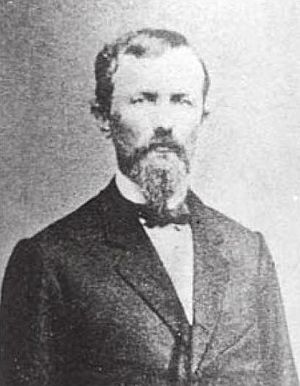Benjamin Franklin Davis facts for kids
Quick facts for kids
Benjamin Franklin Davis
|
|
|---|---|
 |
|
| Nickname(s) | "Grimes" |
| Born | October, 1831 Alabama |
| Died | June 9, 1863 (aged 31) near Brandy Station, Virginia |
| Buried |
West Point Cemetery
|
| Allegiance | |
| Branch | |
| Years of service | 1854–1863 |
| Rank | |
| Unit | 1st U.S. Cavalry Regiment |
| Commands held | 8th New York Cavalry Regiment 1st Brigade, 1st Div., Cavalry Corps |
| Battles/wars | American Civil War |
Benjamin Franklin "Grimes" Davis (October 1831 – June 9, 1863) was a brave American military officer. He served in wars against Native American tribes. Later, he led Union cavalry during the American Civil War. He is well-known for a daring escape he led from Harpers Ferry. This was when Union soldiers were surrounded by Confederate forces. He died in combat during the war.
Contents
Early Life and Military Training
Benjamin F. Davis was born in Alabama in October 1831. He was the oldest of six sons. After his parents passed away, he and his brothers were cared for by their uncle. Davis was a cousin of Jefferson Davis, who later became the president of the Confederacy.
Davis was chosen to attend the United States Military Academy at West Point, New York. He graduated in 1854. Some of his classmates later became famous generals, like Jeb Stuart and Oliver Otis Howard.
Serving on the Frontier
After graduating, Davis first joined the 5th U.S. Infantry. He then transferred to the 1st U.S. Dragoons. These soldiers rode horses and were very important on the frontier. Davis served with the dragoons in New Mexico and California. He was even wounded while fighting the Apache people.
When the Civil War began, Davis decided to stay with the Union. He was promoted to captain in the 1st U.S. Cavalry Regiment. Interestingly, three of his brothers fought for the Confederate States Army.
Leading Cavalry in the Civil War
In June 1862, Davis became a colonel of the 8th New York Cavalry Regiment. He was a strong leader and a strict disciplinarian. One soldier even called him "a proud tyrannical devil." However, the Provost Marshal General of the Army of the Potomac called him "our best cavalry officer."
The Harpers Ferry Escape
In September 1862, Davis and his unit were stationed at Harpers Ferry, West Virginia. The town was surrounded by Confederate troops led by Stonewall Jackson. Davis's commanding officer, Colonel Dixon S. Miles, seemed ready to surrender.
But Davis and another officer, Lieutenant Colonel Hasbrouck Davis, decided to fight their way out. They planned a daring escape. Under the cover of night, about 1,300 Union cavalrymen quietly crossed the Potomac River on a pontoon bridge. They moved through the darkness, avoiding or overpowering Confederate guards.
Capturing a Wagon Train
During their escape, Davis came across a Confederate artillery wagon train. It belonged to Major General James Longstreet. Using his deep Southern accent, Davis tricked the Confederate commander. He ordered them to change direction and accept his unit as an escort.
As the sun rose, the Confederate wagon drivers were shocked to see Union soldiers with drawn pistols. Davis's men not only escaped to Union lines in Greencastle, Pennsylvania, but they also captured Longstreet's forty-wagon supply train! They did this without losing a single soldier. For this amazing feat, Davis was promoted to Major in the Regular Army.
Later Battles and Death
Davis continued to lead his brigade in important battles. He participated in the "Stoneman Raid" during the Chancellorsville Campaign.
In the Gettysburg Campaign, Davis led his brigade at the Battle of Brandy Station. This battle took place on June 9, 1863. In the early morning, Davis's men charged a Confederate artillery battery. They were met by a strong counterattack.
Davis refused to retreat. He fought bravely, swinging his saber and firing his revolver. A Confederate lieutenant named O. R. Allen charged at Davis. He fired his pistol three times at close range. The third shot hit Davis in the forehead, killing him instantly.
Benjamin F. Davis was buried in the West Point Cemetery.

